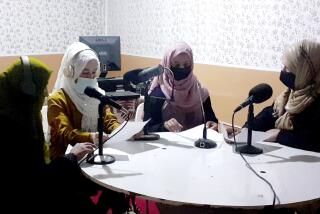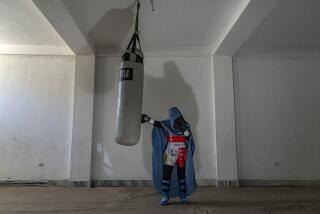Danger and hope
When Havana Marking was growing up in England, her hippie father regaled her with stories of the epic landscape and stunning people he encountered while visiting Afghanistan in the 1960s.
Young Havana was hooked. “I wanted to go there for years and years,” Marking said. “I have done a lot of traveling in Asia and Islamic countries and lived and worked in various Islamic countries. But Afghanistan was this forbidden jewel. I could never go there.”
When U.S., British and other Allied forces invaded eight years ago and toppled the violent Taliban regime, Afghanistan’s doors were open again. Marking, a TV documentarian, tried to find a good subject that would lure her there. “There are a lot of documentaries out there and a lot of boring documentaries,” Marking said on a recent visit to L.A.
“To find something that makes it worth it to go out there and risk your life. . . . So, it had to be a really amazing idea.” A friend put her in touch with British war journalist Rachel Reid, who told her about an “American Idol”-like TV talent competition called “Afghan Star” that was taking the country by storm. “I sat up and said, ‘That is the way in.’ ”
The end result is Marking’s first feature documentary, also titled “Afghan Star,” which opened Friday. Earlier this year, the film won the directing and audience awards at Sundance’s World Documentary competition.
Shot on location in Kabul and other Afghan towns in 2007 and 2008, “Star” follows the three-month process the show takes from its regional auditions to the final competition. And although the show included male and female contestants and brought together various ethnic groups within Afghanistan, not all was peace and harmony along the way.
Music is still considered controversial in the country that, after 30 years of war and recent Taliban rule, has little in the way of civic services and where kidnappings are big business.
“You have no healthcare systems. There is no infrastructure. It has been systematically destroyed. There still aren’t roads in Kabul. There are a few hotels. But Kabul is one of the worst looking because in the civil war it was the one that was most destroyed because everyone was fighting,” said Marking, who kept a bodyguard with her at all times.
On the bright side, because no one seemed to be in charge, she didn’t need permission to shoot anywhere. “I just showed up,” she said. Marking also worked closely with the show’s organizers, Tolo TV. “They gave me complete freedom, and that was the most important thing,” she said. “They came to London, and I met them there. They just knew that I got it. That I would be able to cope in that country. It’s a tough country to be in.”
Still, about 2,000 people auditioned -- among them only three women, two of whom made it to the finals -- and millions of their countrymen watched the show and voted with their cellphones.
Marking follows the four finalists in “Afghan Star.” The two young men, Rafi and Hameed, have gone on to stardom in their country. The two women, though, haven’t.
Setara, a 21-year-old singer who wore makeup and modern fashions, caused an outcry when she danced on the show and had to live in hiding for a time because dancing is forbidden in public. But things have quieted down for her. “She’s still in Kabul singing at weddings,” Marking said. “She’s safe as long as Kabul remains safe. Since last year, the Taliban were getting closer to Kabul. If the Taliban came back, Setara would be one of their first targets.”
But Marking doesn’t know what has happened to Lima, the other young female finalist, who came from one of the most traditionally religious areas of the country.
“There was a report that she fled to Pakistan and was seeking asylum. It’s very difficult to know. There’s a lot of gossip and miscommunications. It’s a lawless country.”
--
More to Read
Sign up for Essential California
The most important California stories and recommendations in your inbox every morning.
You may occasionally receive promotional content from the Los Angeles Times.











